This article was medically reviewed by Sarah Gehrke, RN, MS. Sarah Gehrke is a Registered Nurse and Licensed Massage Therapist in Texas. Sarah has over 10 years of experience teaching and practicing phlebotomy and intravenous (IV) therapy using physical, psychological, and emotional support. She received her Massage Therapist License from the Amarillo Massage Therapy Institute in 2008 and a M.S. in Nursing from the University of Phoenix in 2013.
There are 11 references cited in this article, which can be found at the bottom of the page.
This article has been viewed 116,091 times.
Knee injuries are quite painful but are unfortunately very common, especially for athletes and individuals with weak joints. Tearing your meniscus or having loose fragments in your joint can cause a “locked knee,” which painfully limits the motion of the knee joint. Your knee can also become physically locked in place if the joint in your knee gets stuck. If you have a knee injury, you should make an appointment to see a doctor immediately, but you can also begin to treat the injury at home in the meantime.
Steps
Treating Your Knee at Home
-
1Stop all activity and rest your knee. If you injured your knee during a sporting event or other activity, stop immediately and rest the knee joint. If you have some range of movement in your knee, ask someone to help you walk to the nearest safe place to sit, and rest for as long as possible. Additional movement can further damage the knee joint.[1]
- If you have no movement in your knee, visit the doctor immediately or contact emergency services, as it might be a broken or dislocated kneecap, which requires immediate medical attention.
-
2Ice the knee immediately. Placing ice on the knee will help to reduce pain and the effects of swelling. It’s best to leave the ice on for 30 minutes at a time. You can put ice on the locked knee every 3 or 4 hours for 2-3 days after the injury.[2]
- Refrain from applying heat to a knee injury until a doctor tells you it’s appropriate. Heat can cause more inflammation of the area and increase swelling, limiting your movement further.
- If the pain is recurring, you have arthritis, or you’ve injured the knee before, alternate between ice and heat to relax the muscles and joints after any swelling has gone down.
Advertisement -
3Elevate your knee above your heart. Keeping the knee elevated will also help to reduce swelling and limit use of the knee. You can do this by placing a few pillows under your heel and knee while you are lying down. If you need to sit up or feel more comfortable that way, still keep the knee elevated out in front of you by propping it on a nearby chair or stool.[3]
- Make sure your back and neck are properly supported to avoid injuring other areas of your body.
-
4Wrap the knee using an elastic bandage. This will compress the knee joint and help to control swelling, which can cause pain and discomfort. You can find elastic bandages at most grocery stores in the health and wellness section, or get one from the nearest pharmacy. If you have one, you can use a neoprene “brace” made specifically for the knee joint instead of an elastic bandage.[4]
- Make sure you aren’t wrapping the bandage too tightly. Be aware of circulation loss, and make sure you can comfortable put your finger between the bandage and the knee.
-
5Take NSAIDs to relieve pain and swelling. Non-steroidal anti-inflammatory drugs (NSAIDs) such as Advil and Motrin, generically known as Ibuprofen, and Aleve, also known as Naproxen, help to reduce swelling and manage pain. Follow the directions on the packaging to find dosage levels appropriate for you. You should only take these medications as needed, because they can have harmful side effects, such as risk for bleeding or the formation of ulcers.[5]
- Always read and follow the package instructions for any medication before you take it.
-
6Ask your doctor about alternative forms of pain management. Treatments such as acupuncture, cortisone shots, or electrotherapy are very effective at alleviating pain for some certain patients. They can be cost effective and help you to feel your best quickly after an injury.[6]
Visiting a Doctor
-
1Call your primary care physician to request an appointment as soon as possible. As soon as the knee injury occurs, you should make an appointment with your usual doctor to have them check on it. Try to get an appointment as soon as possible after the injury because waiting can cause additional damage to the joint.[9]
- Most family doctors have seen many knee injuries and will be able to give you medical advice right away, depending on the severity of the injury.
- Your doctor may need to do an X-ray or MRI to properly assess your knee injury.[10]
- If you don’t have a primary care physician, you can visit an urgent care or express care facility for treatment.
- If at any point you lose motion in your knee and cannot reach a physician, go to the emergency room for immediate medical attention.
-
2Schedule to see a physical therapist to help regain movement in your knee. A physical therapist will be able to give you a set of stretches and activities to complete at home that will help your knee heal. After an injury, they will normally teach you how to do the stretches first, have you practice them at home every day, and have you visit on a regular basis to track your improvement.[11]
- In some cases, you will need a doctor’s recommendation or prescription to see a physical therapist.
- Make sure the physical therapist is covered by your insurance. Even with a doctor’s referral, only some physical therapist’s offices in your area will be considered “in network” and covered by your insurance.
-
3Visit an orthopedic surgeon if you have a severe injury. In severe cases, a locked knee will require surgery to relieve the pain and regain motion in the knee joint. If you have continuing pain, your doctor will refer you to visit a surgeon to discuss further options for treatment. Knee surgery is normally performed in a non-invasive manner and is very safe for the patient.[12]
- When it comes to surgery, it is helpful to get more than one opinion. If you are unsure or confused after visiting the surgeon referred by your doctor, seek a second opinion from a different surgeon.
- Many common knee injuries, such as ligament and meniscus tears, are performed arthroscopically. Arthroscopic surgery is a minimally invasive procedure that uses robotic arms controlled by the surgeon to work with high levels of precision in small, delicate areas.[13]
Preventing Further Injury
-
1Rest when you need to. If you’re feeling tired, your knee is aching or throbbing, or you’re having other pain in the leg area, take time to rest. Many people report feeling stiff or weak in the knee joint even after recovering from an injury. Take a seat and elevate your leg for a while if you feel overexerted or are having pain.[14]
-
2Take your time getting back into intense activities. Activities such as running, hiking, biking, yoga, and most team sports are hard on the knee joints. Work your way up to these activities by focusing on gaining strength and movement first.[15]
- For example, if you’re interested in hiking, you might start by walking around the neighborhood up and down small inclines. Once you’re comfortable with that, you can start climbing stairs to gain strength in the knees. Over time, you can work up to hiking less intensive paths before taking on moderate and then more difficult trails.
-
3Remain active year-round by doing low-impact exercises. Not moving the knee joint can sometimes be as harmful as overuse. Try to incorporate walking, swimming, or stretching into your everyday routine to avoid stagnation of the joint, which can cause stiffness.[16]
- If you play a sport with an offseason, commit to some form of practice or stretching every day. Doing so can prevent re-injury when you resume playing in the regular season.
Warnings
- Taking NSAIDs can cause an increased risk for bleeding or ulcers.⧼thumbs_response⧽
- If you don’t see improvement after 3 days of at-home care, visit your doctor.⧼thumbs_response⧽
References
- ↑ https://www.webmd.com/pain-management/knee-pain/meniscus-tear-injury#2
- ↑ https://my.clevelandclinic.org/health/diseases/17219-meniscal-tears
- ↑ https://bonesmart.org/forum/threads/elevation-the-dos-and-donts.7602/
- ↑ https://www.webmd.com/pain-management/knee-pain/meniscus-tear-injury#2
- ↑ https://emedicine.medscape.com/article/90661-treatment
- ↑ https://www.mayoclinic.org/tests-procedures/cortisone-shots/about/pac-20384794
- ↑ http://www.nsmi.org.uk/articles/sports-physicians/electrotherapy.html
- ↑ https://www.health.harvard.edu/blog/acupuncture-knee-arthritis-fails-one-test-may-still-worth-try-201410017470
- ↑ https://emedicine.medscape.com/article/90661-treatment
- ↑ https://methodistsouthlake.com/knee-locking/
- ↑ https://emedicine.medscape.com/article/90661-treatment
- ↑ https://my.clevelandclinic.org/health/diseases/17219-meniscal-tears
- ↑ https://orthoinfo.aaos.org/en/treatment/arthroscopy/
- ↑ https://www.bupa.co.uk/health-information/knee-clinic/knee-health-support/exercises-to-prevent-knee-injury
- ↑ https://www.bupa.co.uk/health-information/knee-clinic/knee-health-support/exercises-to-prevent-knee-injury
- ↑ https://kidshealth.org/en/parents/knee-injuries.html#
About This Article
Locked knees can be painful and sometimes serious, so see your doctor for treatment. However, in the meantime, you can unlock your knee by reducing the swelling. Ice your knee as soon as it locks up, since this will prevent it from getting worse. You can use ice for 30 minutes at a time every 3-4 hours. You should also elevate your knee above your heart while you rest to reduce swelling. If you have to go anywhere, wrap your knee in an elastic bandage. Just don’t wrap it too tightly or you might cut off your circulation. You can also take an over-the-counter pain killer to reduce your discomfort while you heal. To learn how physical therapy can help you unlock your knee, read more from our Medical co-author!
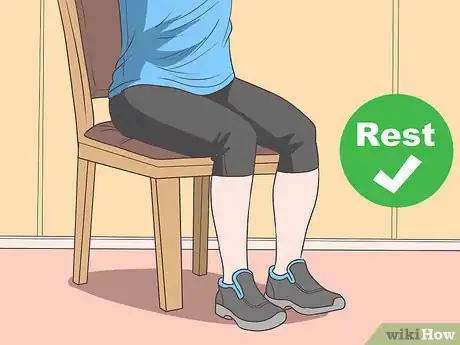
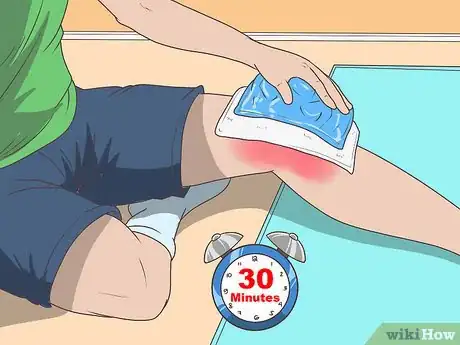
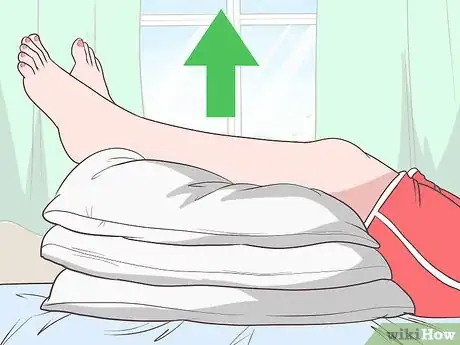
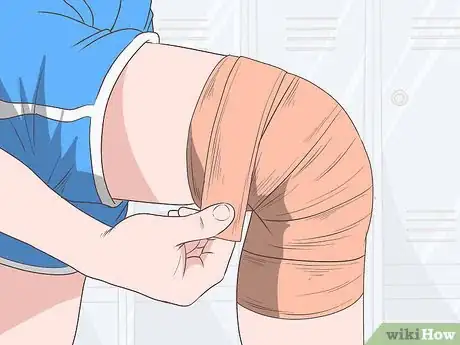



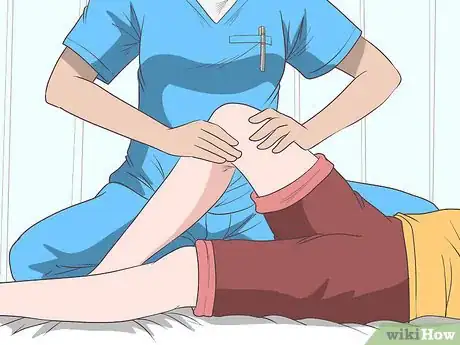
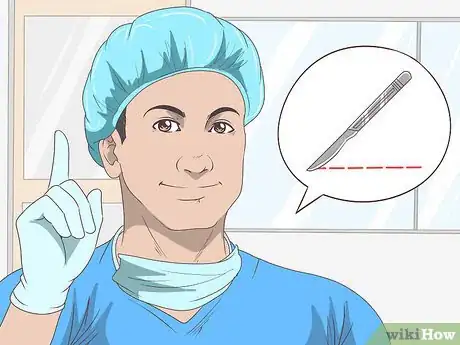

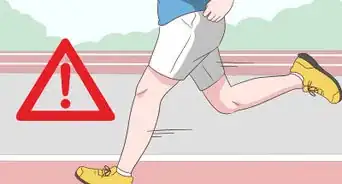





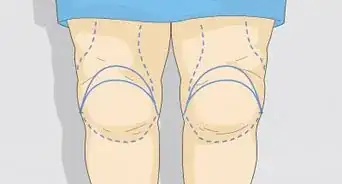

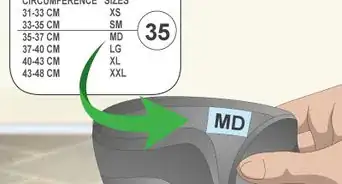
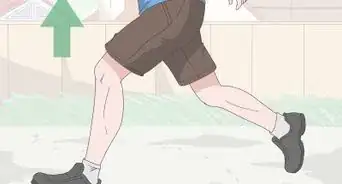
















































Medical Disclaimer
The content of this article is not intended to be a substitute for professional medical advice, examination, diagnosis, or treatment. You should always contact your doctor or other qualified healthcare professional before starting, changing, or stopping any kind of health treatment.
Read More...